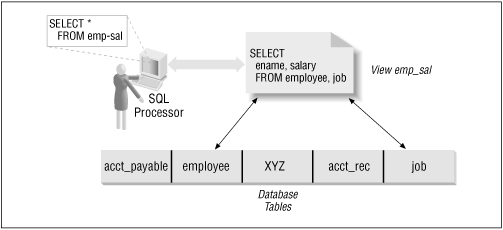Views
Oracle allows a definition to be stored in the data dictionary that describes how data is to be retrieved from one or more tables. This logical definition is called a view. A view may be thought of as a layer on top of the tables that actually contain the data. Views do not store any data themselves; they only define what data is to be retrieved and, in many cases, the restrictions for retrieving the data. Views are treated exactly like tables when data is being selected. In fact, in the sample statement below, there is no way to tell if the table emp_sal specified in the query is really a table or a view:
SELECT employee_name, current_salary FROM emp_sal;
Figure 3.1 shows how a user would access the view as though it were a table and how execution of the view causes required data to be retrieved from several tables.

Figure 3-1. View implementation
Views can be used for several purposes relevant to security; for example, they can simplify user access by pre-joining tables and they can limit the data retrieved.
Using Views
Consider the two tables referenced in Figure 3.1: employee and salary. The employee table contains the constant employee information such as name, social security number, and other basic data which is not expected to change. The salary table contains the employee number along with the employee’s job, when the job was started and ended, as well as the salary. This ...
Get Oracle Security now with the O’Reilly learning platform.
O’Reilly members experience books, live events, courses curated by job role, and more from O’Reilly and nearly 200 top publishers.

